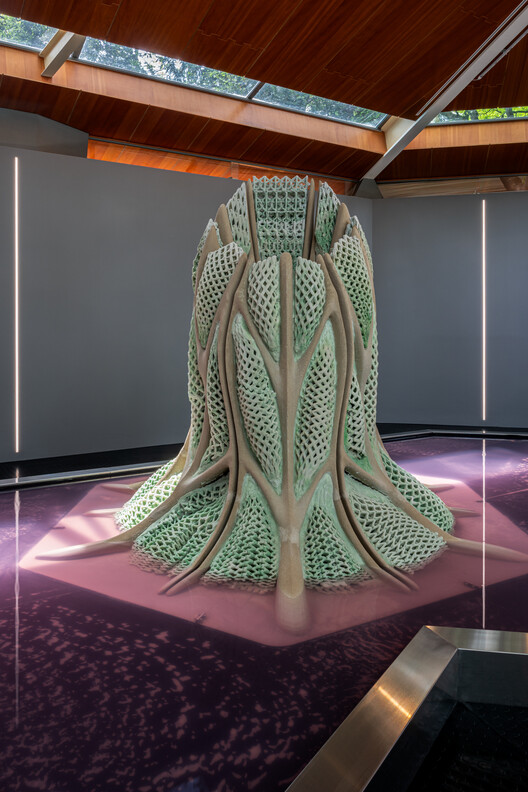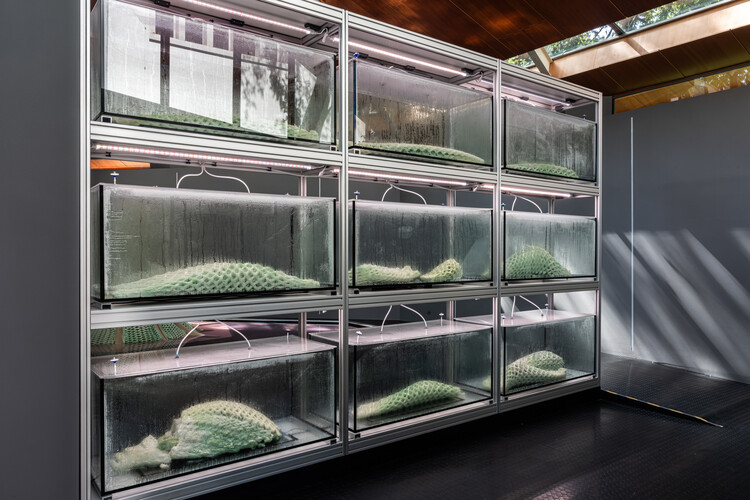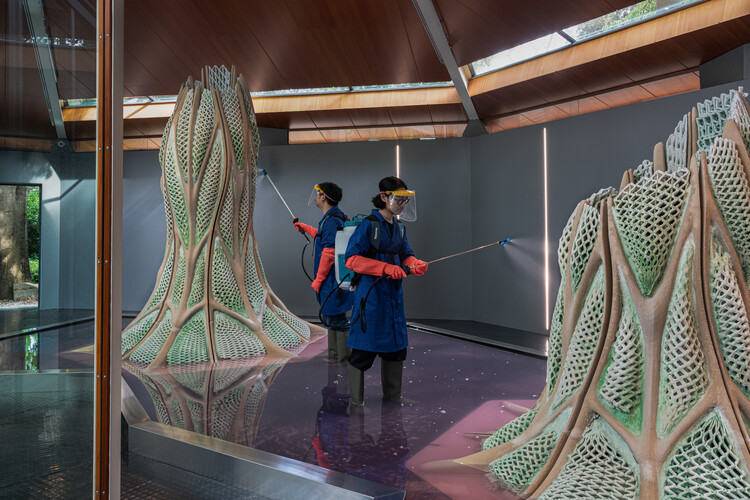 Living Room Collective: Picoplanktonics, Canada Pavilion at the Venice Biennale, 2025. Image © Valentina Mori
Living Room Collective: Picoplanktonics, Canada Pavilion at the Venice Biennale, 2025. Image © Valentina Mori
Share
Share
Or
https://www.archdaily.com/1030289/canada-pavilion-presents-picoplanktonics-a-living-experiment-in-regenerative-architecture-at-the-2025-venice-biennale
The Canada Council for the Arts presents Picoplanktonics at the Canada Pavilion as part of the 19th International Architecture Exhibition – La Biennale di Venezia, which will run until November 23, 2025. Developed by the Living Room Collective, the installation engages with ongoing global ecological challenges through a speculative, research-driven approach to design, featuring 3D-printed architectural structures embedded with living cyanobacteria capable of carbon sequestration. Developed through a four-year collaboration led by Andrea Shin Ling and a group of interdisciplinary contributors, the project investigates the potential of co-constructing built environments with living systems.
The Living Room Collective is composed of architects, scientists, artists, and educators working at the intersection of architecture, biology, and digital fabrication technologies. Led by Canadian architect and biodesigner Andrea Shin Ling, the core team members include Nicholas Hoban, Vincent Hui, and Clayton Lee. The collective seeks to transition away from extractive models of production by developing design methods and processes grounded in natural systems. For the team, the Biennale Architettura 2025 serves as a platform to provoke national and international dialogue around questions central to the future of architecture: How does one fabricate a biological architecture? What are the conditions of stewardship? And what strategies might scale such approaches regionally and globally?
The structures featured in the pavilion were fabricated using a novel biofabrication platform developed at ETH Zürich. Capable of printing living materials at architectural scale, the system represents a significant advancement in sustainable building technologies. The result is the largest known architectural installation composed of living materials. Within the Canada Pavilion, the exhibition space has been adapted to accommodate the biological needs of the cyanobacteria, with careful calibration of light, humidity, and temperature to allow the organisms to thrive throughout the exhibition’s duration.
Related Article “Architecture is Survival”: In Conversation with Curator Carlo Ratti at the 2025 Venice Architecture Biennale  Living Room Collective: Picoplanktonics, Canada Pavilion at the Venice Biennale, 2025. Image © Valentina Mori
Living Room Collective: Picoplanktonics, Canada Pavilion at the Venice Biennale, 2025. Image © Valentina Mori Living Room Collective: Picoplanktonics, Canada Pavilion at the Venice Biennale, 2025. Image © Valentina Mori
Living Room Collective: Picoplanktonics, Canada Pavilion at the Venice Biennale, 2025. Image © Valentina Mori
Picoplanktonics embodies an ecology-first design ethos, integrating ancient biological processes with contemporary fabrication methods. It is conceived as an ongoing experiment in regenerative construction, emphasizing the reciprocal relationships between humans, the built environment, and living organisms. Caretakers will remain on site for the duration of the exhibition, underscoring the role of long-term stewardship and maintenance in this ecological approach to design. The installation ultimately seeks to question conventional paradigms of building and material production. Rather than focusing solely on human survival, it explores modes of resilience that include broader ecological systems, reimagining how architecture might operate within and contribute to planetary restoration.
 Living Room Collective: Picoplanktonics, Canada Pavilion at the Venice Biennale, 2025. Image © Valentina Mori
Living Room Collective: Picoplanktonics, Canada Pavilion at the Venice Biennale, 2025. Image © Valentina Mori Living Room Collective: Picoplanktonics, Canada Pavilion at the Venice Biennale, 2025. Image © Valentina Mori
Living Room Collective: Picoplanktonics, Canada Pavilion at the Venice Biennale, 2025. Image © Valentina Mori
The 2025 Venice Architecture Biennale opened on May 10 and will run until November 23. This year’s edition brings together over 300 contributions from more than 750 participants across generations and disciplines. Hosting a total of 65 national pavilions, four countries, Azerbaijan, Oman, Qatar, and Togo, are participating for the first time. The Azerbaijan national pavilion presents Equilibrium. Patterns of Azerbaijan, the Republic of Togo presents the exhibition titled Considering Togo’s Architectural Heritage, The Sultanate of Oman is presenting its debut national pavilion titled Traces, centers on the “Sablah,” a traditional Omani communal space typically found in villages and neighborhoods, as a case study in architectural resilience and cultural continuity, and Qatar presents a two-part exhibition organized by the Future Art Mill Museum, and also has announced that architect Lina Ghotmeh, founder and principal of the Paris-based studio Lina Ghotmeh — Architecture, has been selected to design its permanent national pavilion in the Giardini della Biennale.
We invite you to check out ArchDaily’s comprehensive coverage of the 2025 Venice Biennale.





 Living Room Collective (upper left clockwise: Nicholas Hoban, Vincent Hui, Andrea Shin Ling, Clayton Lee), 2025. Image © Girts Apskalns
Living Room Collective (upper left clockwise: Nicholas Hoban, Vincent Hui, Andrea Shin Ling, Clayton Lee), 2025. Image © Girts Apskalns Living Room Collective: Picoplanktonics, Canada Pavilion at the Venice Biennale, 2025. Image © Valentina Mori
Living Room Collective: Picoplanktonics, Canada Pavilion at the Venice Biennale, 2025. Image © Valentina Mori